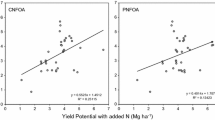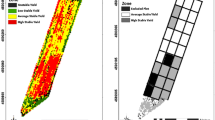Abstract
Several methods were developed for the redistribution of nitrogen (N) fertilizer within fields with winter wheat (Triticum aestivum L.) based on plant and soil sensors, and topographical information. The methods were based on data from nine field experiments in nine different fields for a 3-year period. Each field was divided into 80 or more subplots fertilized with 60, 120, 180 or 240 kg N ha−1. The relationships between plot yield, N application rate, sensor measurements and the interaction between N application and sensor measurements were investigated. Based on the established relations, several sensor-based methods for within-field redistribution of N were developed. It was shown that plant sensors predicted yield at harvest better than soil sensors and topographical indices. The methods based on plant sensors showed that N fertilizer should be moved from areas with low and high sensor measurements to areas with medium values.
The theoretical increase in yield and N uptake, and the reduced variation in grain protein content resulting from the application of the above methods were estimated. However, the estimated increases in crop yield, N-uptake and reduced variation in grain protein content were small.





Similar content being viewed by others
References
Baden, G., Williams, A., & Hoey, D. (1987). The use of electromagnetic induction to detect the spatial variability of salt and clay content of soils. Australian Journal of Soil Resources, 25, 21–27.
Ebertseder, Th., Gutser, R., Hege, U., Brandhuber, R., & Schmidhalter, U. (2003). Strategies for site specific nitrogen fertilisation with respect to long-term environmental demands. In J. Stafford, & A. Werner (Eds.), Precision agriculture (pp. 193–198). Wageningen: Academic Publishers.
Flowers, M., Weisz, R., & Heiniger, R. (2003). Quantitative approaches for using color infrared photography for assessing in-season nitrogen status in winter wheat. Agronomy Journal, 95, 1189–1200.
Greve, M. H., Nehmdahl, H., & Krogh, L. (2003). Soil map** on the basis of soil electric conductivity measurements with EM38. In B. Linden, & S. E. Olesen (Eds.), Implementation of precision farming in practical agriculture (pp. 26–34). Denmark: Dias report no 100, Danish Institute of Agricultural Science.
Hansen, P. M., Skjødt, P., & Jørgensen, R. N. (2003). Algorithm for variable nitrogen rate—application in winter wheat. In B. Linden, & S. E. Olesen (Eds.), Implementation of precision farming in practical agriculture (pp. 56–64). Denmark: Dias report no 100, Danish Institute of Agricultural Science.
Heiniger, R. W., McBride, R. G., & Clay, D. E. (2003). Using soil electrical conductivity to improve nutrient management. Agronomy Journal, 95, 508–519.
Iqbal, M. (1983). An introduction to solar irradiation. USA: Academic Press Inc.
Jiang, P., & Thelen, K. D. (2004). Effects of soil and topographic properties on crop yield in a north-central corn–soybean crop** system. Agronomy Journal, 96, 252–258.
Joernsgaard, B., & Halmoe, S. (2003). Intra-field yield variation over crops and years. European Journal of Agronomy, 19, 23–33.
Kitchen, N. R., Drummond, S. T., Lund, E. D., Sudduth, K. A., & Buchleiter, G. W. (2003). Soil electrical conductivity and topography related to yield for three contrasting soil–crop systems. Agronomy Journal, 95, 483–495.
LaRuffa, J. M., Raun, W. R., Phillips, S. B., Solie, J. B., Stone, M. L., & Johnson, G. V. (2001). Optimum field element size for maximum yields in winter wheat, using variable nitrogen rates. Journal of Plant Nutrition, 24, 313–325.
Lowenberg-DeBoer, J., & Swinton, S. (1997). Economics of site-specific management in agronomic crops. In P. Robert, R. Rust, & W. Larson (Eds.), The state of site-specific management for agriculture: Proceedings of the 3rd international conference on precision agriculture, Madison, WI, USA, pp. 369–396.
Lund, E. D., Wolcott, M. C., & Hanson, G. P. (2001). Applying nitrogen site-specifically using soil electrical conductivity maps and precision agriculture technology. The Scientific World, 1, 767–776.
Lukina, E. V., Freeman, K. W., Wynn, K. J., Thomason, W. E., Mullen, R. W., Stone, M. L., Solie, J. B., Klatt, A. R., Johnson, G. V., Elliott, R. L., & Raun, W. R. (2001). Nitrogen fertilization optimization algorithm based on in-season estimates of yield and plant nitrogen uptake. Journal of Plant Nutrition, 24, 885–898.
Pedersen, C. A. (2002). Oversigt over Landsforsøgene (in Danish). Denmark: Danish Agricultural Advisory Service.
Raun, W. R., Solie, J. B., Johnson, G. V., Stone, M. L., Mullen, R. W., Freeman, K. W., Thomason, W. E., & Lukina, E. V. (2002). Improving nitrogen use efficiency in cereal grain production with optical sensing and variable rate application. Agronomy Journal, 94, 815–820.
Reuter, H. I., Wendroth, O., Kersebaum, K. C., & Schwarz, J. (2001). Solar radiation modelling for precisions farming—a feasible approach for better understanding variability of crop production. In G. Grenier, & S. Blackmore (Eds.), Third European conference on precision agriculture (pp. 845–850). Montpellier, France: ECPA.
SAS Institute (1996). SAS/STAT software: Changes and enhancements through release 6.11. Cary, NC, USA: SAS Institute Inc.
Solie, J. B., Raun, W. R., & Stone, M. L. (1999) Submeter spatial variability of selected soil and Bermudagrass production variables. Soil Science Society of America Journal, 63, 1724–1733.
Vrindts, E., Reyniers, M., Darius, P., De baerdemaeker, J., Gilot, M., Sadaoui, Y., Frankinet, M., Hanquet, B., & Destain, M.-F. (2003). Analysis of soil and crop properties for precision agriculture for winter wheat. Biosystems Engineering, 85, 141–152.
Wollring, J., Reusch, S., & Karlsson, C. (1998). Variable nitrogen application base on crop sensing. Proceedings No. 423. UK: The International Fertiliser Society.
Welsh, J. P., Wood, G. A., Godwin, R. J., Taylor, J. C., Earl, R., Blackmore, B. S., Spoor, G., & Thomas, G. (1999). Develo** strategies for spatially variable nitrogen application. In J. V. Stafford (Ed.), Precision agriculture ‘99: Proceedings of the 2nd European conference on precision agriculture. Sheffield, UK: Sheffield Academic Press.
Yang, C., Peterson, C. L., Shropshire, G. J., & Otawa, T. (1998). Spatial variability of field topography and wheat yield in the Palouse region of the Pacific Northwest. Transactions of the ASAE, 41, 17–27.
Zadoks, J. C., Chang, T. T., & Konzak, C. F. (1974). A decimal code for the growth stages of cereals. Weed Research, 14, 415–421.
Acknowledgements
The algorithm development is based on field experiments and data analysis funded by the research programmes ‘Applied crop research’ financed by the Danish Agricultural Advisory Service and ‘Agriculture from a holistic resource perspective’ financed by the Danish Ministry of Food, Agriculture and Fisheries.
We wish to thank the following farmers and estates that have hosted the field experiments for their outstanding cooperation: Knud Gasbjerg, Carsten Jensen, Svend Laier, Egeskov Gods, Østergård Hovedgård, Ove Christoffersen, Geert H. de Lichtenberg, H.C. Neergård and Niels Balle. We also wish to thank Margit Schacht for greatly improving the readability of the paper.
Author information
Authors and Affiliations
Corresponding author
Appendix A
Appendix A
This appendix describes how to maximize yield (Eqs. 5, 6) given a fixed N application rate (Eq. 7). From Eq. 7 it can be seen that the N ij ’s depend on each other. Thus, simultaneous maximization of Eqs. 6, 7 is not immediately possible. However, Eq. (6) can be rearranged to
Eqs. 5, 6 can now be reduced to
This equation is simplified by setting \(\alpha _{ij} = \left( {b_i + f_i S_{ij} + g_i S_{ij}^2 + h_i S_{ij}^3 } \right)\):
In this equation the N ij ’s are independent and \(Y_i^* \) can be maximized by setting the partial derivative of \(Y_i^* \) with respect to N ij to zero:
Eq. (15) is now differentiated and inserted into Eq. (16):
This equation is solved with respect to N ij using Eq. (13).
Combining this equation with Eq. (13) gives
This equation is then solved with respect to \(N_{ik_i } \)
Finally, this is inserted into Eq. (18)
Expanding \(\alpha _{ij} \) gives
To obtain a global model of how to redistribute N based on a sensor measurement (S ij ), it is evident from the above equation that a i , f i , g i and h i cannot be estimated for each field but must be determined as common factors for all experiments. It is also noted that b i and the sum are constants within a single field, which implies that Eq. (22) can be rewritten as
Under field conditions \(\gamma _i \) can be determined by noting that
and by combining Eqs. 6, 22 the following expression is obtained:
Rights and permissions
About this article
Cite this article
Berntsen, J., Thomsen, A., Schelde, K. et al. Algorithms for sensor-based redistribution of nitrogen fertilizer in winter wheat. Precision Agric 7, 65–83 (2006). https://doi.org/10.1007/s11119-006-9000-2
Published:
Issue Date:
DOI: https://doi.org/10.1007/s11119-006-9000-2




